With all the content in hand, should you give up or still make it work? Many choose the latter. Learn how to reoptimize old content and give them the traffic needed.
Is your underperforming content worth re-optimizing? If yes, then how should you be doing content optimization? Read on to find out!
Nowadays, SEO is all about the contents, right? Over 4 million blog posts are published online every day, and unfortunately, not every piece of content created is going to be a winner. Somehow every marketer has felt this way before- the very blog post that you once carefully crafted is now sitting stagnant in the search results. You feel that its momentum is dying out but it has so much potential.
That is what underperforming content is. The content is either getting less organic traffic or it didn’t even get any traffic despite the efforts you might have put in. This is because several factors can contribute to it.
1. Irrelevant statements and information
For example, if your content is about information for a specific niche, say, new mothers, then if you pointlessly go and address matters that are exclusively relevant for fathers, then it is of no use. If you continue to post content that contains information and statements that are irrelevant to your main topic, in the long run, it will do you more harm than any good.
Always do research and know your market before delivering.
2. Plagiarised & duplicated content
Plagiarism is a serious offense and it could sabotage your reputation. As a result, your SEO ranking will drop as your content will be penalized. To avoid this, always check for plagiarism using some tools available online before publishing your content.
If you happen to cover the same or somewhat familiar keyword topic with multiple pages, duplication will lead to a loss in organic visibility. Besides, repetitive content will also diminish your worth and will make your audience start doubting the credibility and authenticity of your content.
3. No keyword research beforehand
Choosing the right keywords is more important than you think. If you choose keywords that have a low ranking and high competition, this will lower the chance of your content appearing in the SERP.
Keyword is king when it comes to SEO.
4. No backlinks
Backlinks can improve your SEO ranking in Google and without it, no good will come to your content even if it’s compelling on its own. Take this study conducted by Moz for example 99.2% of all top 50 results in Google have at least one backlink in their content.
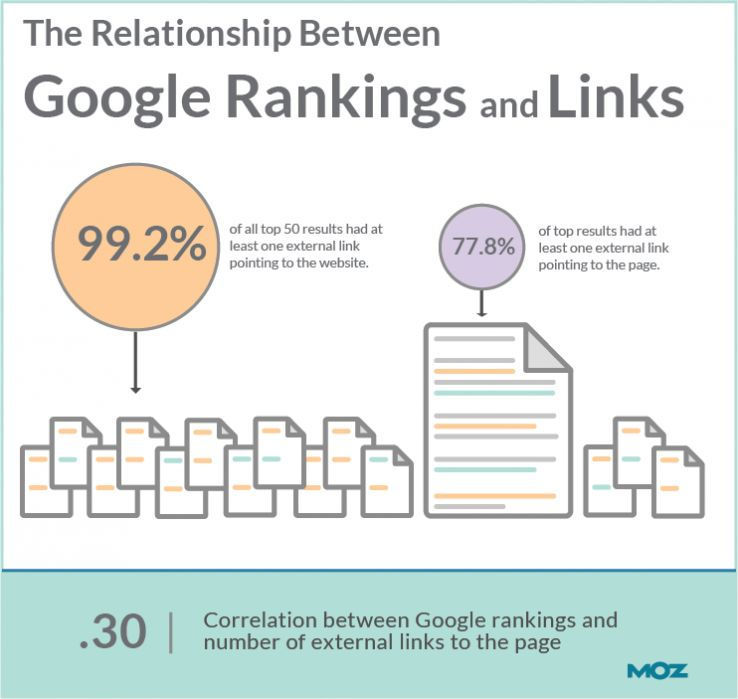
Google prefers to rank articles that have more links from others as it is more trustworthy. Just think of it sort of like a vote from others.
5. Messy and disordered presentation
Jumbled-up data and unsystematic displays are too messy and disordered and in a way, it will give the readers a tough time to read and navigate through your content.
Always do your research on how to construct your content and the infographics or displays orderly. Try to not add too much graphical data as it will look very suffocated and keep people from coming back to your blog.
Now that you know what contributes to your underperforming content, it’s time to take action.
Why you should reoptimize old content?
1. Content can expire
If you have outdated content, don’t expect that it can attract new readers. Contents need to be updated from time to time in order to keep your information relevant.
Even evergreen content needs to be updated and undergo content optimization.
Keep in mind that user behavior is extremely vital as it deeply affects how the search engine ranks your content.
User signals like return-to-SERP where the user returns to the search result page is a negative signal as it tells the search engine that your site does not fulfill the user requirement.
This will likely happen if your content is outdated and once the user sees the publish date, they will return to the search page looking for an alternative answer. This signal will lower your rankings on the search page and hence, less organic traffic to your site.
How can you possibly avoid this? The answer is simple, reoptimize your content.
2. Old content has true long-term values
![How Often Should You (or Your Company) Blog? [New Data]](https://img.playbuzz.com/image/upload/ar_1,c_crop/q_auto:good,f_auto,fl_lossy,w_640,c_limit,dpr_2.5/v1594827742/qlfbfcmbpnh1seqwpai4.png)
One study by ReferralRock on 55 marketers showed that 40% of them generated more than 30% of their leads from old blogs while a quarter of the marketers generated over 50% of their leads from old posts.

95% of the marketers update their content that they originally published over 6 months ago. From this statistic, you can clearly see that updates to old posts are connected to the traffic that they bring in.
It is no doubt that it is well worth to re-optimize your old content.
3. The search engine algorithm is ever-changing
Yes, everything can evolve including the search engine and it’s happening quickly. New technology, new rules, and standards can all shift search intent.
To have a successful SEO process, it is important your content is relevant. Thus, you should always reoptimize your content with relevant keywords that can help you to adapt to the evolving search intent, algorithm, and Google trends.
Take this graph as an example:

If you wrote a blog about cell phones then it is without a doubt that your blog is outdated. Now if you change the main keyword “cell phone” to a more valuable keyword like “smartphone”, you can see that the search traffic increased.
When you do that, there is a high chance that Google and other search engines will show users your content because it is more relevant.
How should you reoptimize underperforming content?
Many studies have shown that content optimization has increased organic traffic, take this Top Company Newsletter article for an example:
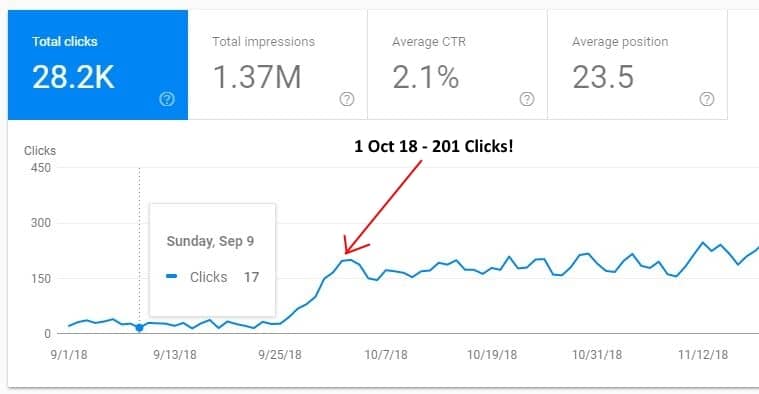
It can be seen from this graph that after re-optimizing their article which was first published in 2017, the organic traffic and keywords increased drastically.
With that pointed out, let’s get started on how to reoptimize old content for SEO.
1. Seek fresh, relevant keywords
One of the main reasons why you missed your mark initially is not because of Google or that you published your post at the wrong timing. It is but rather the wrong choice of the keyword as we pointed out.
People’s interest changes over time and the best way to keep up with the latest trends or practices is to research your keywords. Always look for related best-performing keywords to include in your content.
You can do this with BiQ’s Keyword Intelligence tool.

Reoptimize content with long-tailed keywords tends to perform better in search engines. This is because these keywords are highly specific and have less competition, hence easier for ranking.
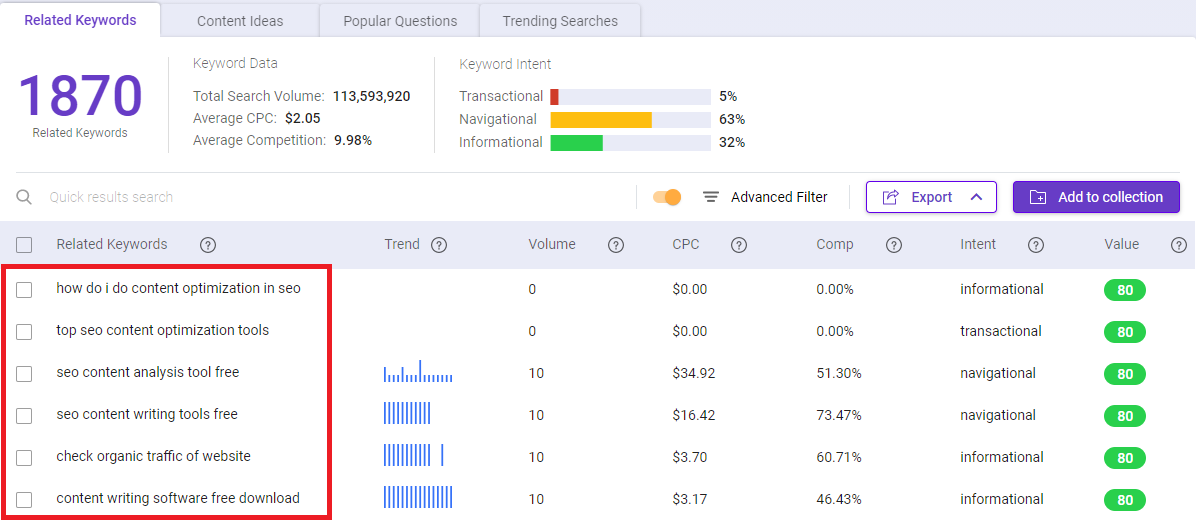
BiQ’s Keyword Intelligence tool enables you to enter your target keywords, where you’ll then get a list of long-tailed keywords. If you are unsure what long-tailed keyword to use, then you can sort the keywords based on their value. The higher valued keyword means it can potentially bring more traffic to your website at a lower competition.
Besides that, you can also use BiQ’s Keyword Intelligence tool to help you match the user intent to your content! This is a great function because it can help you eliminate assumptions and guesswork to identify the searchers’ intent.
Let’s say you want to know the searcher’s intent when searching for ‘content marketing.’ Type them into the keyword tool.
It will show you the estimated keyword intent percentages based on the total number of related keywords.

The keyword has an informational intent from the example above, which means the searchers are in the awareness stages.
Since the searchers are looking for more information, you can create informational content such as ‘why do you need content marketing?’ and ‘top content marketing examples’.
2. Consolidate multiple “similar” articles into one
If you have multiple articles with keywords targeting the same intent, there is a chance that cannibalization can occur since they are competing for positions. Ultimately, it is better to have one awesome post than two or a few medium articles.
When you consolidate them into a single, long-form piece of content, the result is a higher-quality post with more authority on your niche.
Google in particular loves long content, and on average, long articles rank higher on Google search pages compared to shorter ones. You also won’t have to compete with yourself in the SERPs.
There are many advantages when you consolidate your posts which will in turn reap higher audience engagement, organic traffic, and higher ranking.
All in all, less is more.
3. Work on linking your efforts
Using external and internal links on your website will consequently improve the search visibility and rank of your site.
Internal links are hyperlinks that will direct the reader to your target page on your website meanwhile external links as the name implies will direct readers to a different website other than yours.
External links may seem contradictory but if you link to reputable and trustworthy websites, it will not only build your authority, but it will also help the search engine understand your site intent.
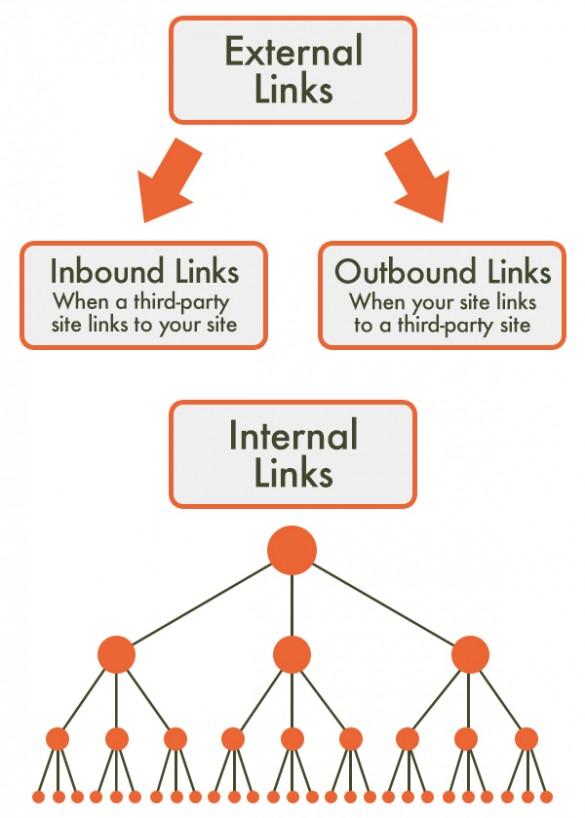
Internal linking can help your users and search engines understand your website’s pages and structure. If you linked to page 1 to page 2, which is relevant to page 1, then users can navigate without leaving your website and this will, in turn, improve website visibility on the search page.
External links on the other hand can help you build credibility to your website when you link to informative and trustworthy websites that are relevant and popular. The higher the rank of the external link the more value it will provide to your website.
4. Reoptimize old content into high-quality ones
It is without a doubt that reoptimizing an old blog into a high-quality one takes less effort than creating something new from scratch.
High-quality content should include a variety of keywords, at least 3 high- valued keywords per page.
You can do this with BiQ’s Content Intelligence tool where you can edit and reoptimize old content effortlessly.
All you need to do is to enter your target keyword and page URL, where you’ll then receive a full analysis of your content.
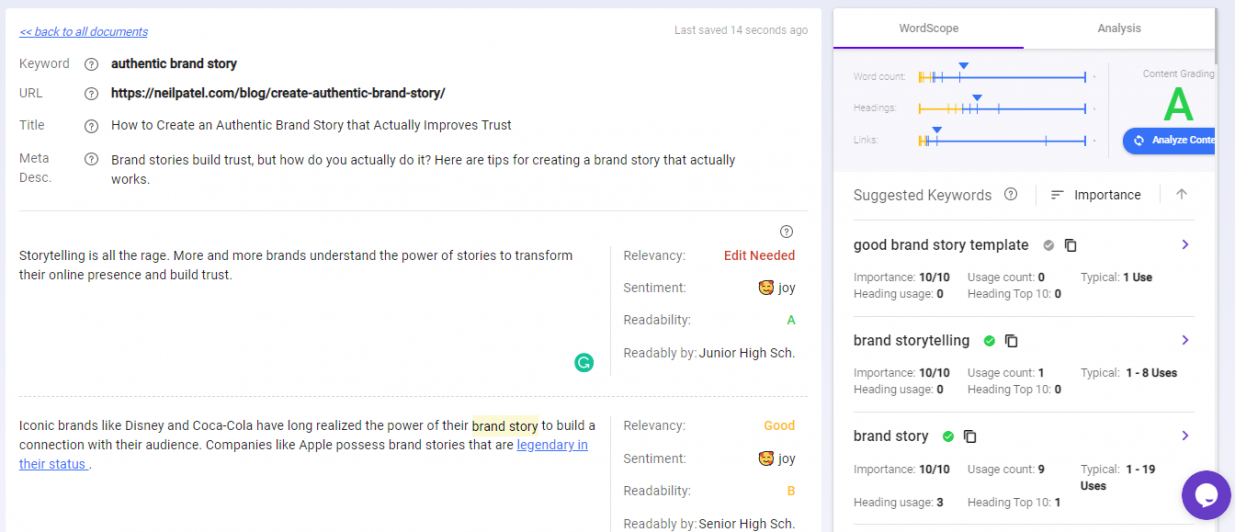
On the right, you can see a variety of keywords that you can include in your content for the target keyword “optimize content”.
Do this and you can reap the rewards of ranking well on the SERPs.
5. Check if your basics of content optimization were done
The basics of content optimization are very important as they can help to improve the readability of your page. Readability is an important factor to keep leads engaging with your blog post.
The basics of content optimization to consider are:
Is your content structured with headings?
You can use headings or subheadings to break up your content into sections as it will make your page easier to skim.
When you include headings in your website, not only is your content more readable but it also can help your site rank for relevant keywords. Google prioritizes HTML header tags as it crawls into your website to look at your headings and subheadings to understand the context of your website.
Does your title tag and meta description explain the content and have keywords?
Your title tag plays an important role in SEO. This is because, from a user perspective, your title tag is the first piece of information people see from your content.
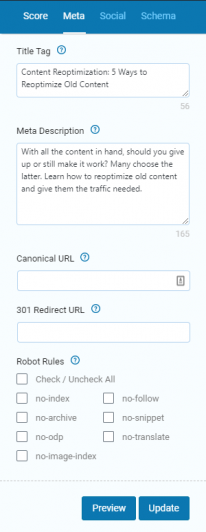
Create interesting, unique, and informative title tags that will motivate or “hook” users to click.
Meta descriptions are not a ranking factor anymore but they still help to entice readers to click into your site. From a CTR perspective, they still matter.

Write it like a sales copy to boost engagement and increase visits from organic search!
Are images alt text included?
Image SEO is one of the overlooked areas of SEO, but that doesn’t have to be the case. Image optimization is important because it can help to rank higher on Google Image Search and to improve overall visibility and optimization of a web page.
Alt text for images is basically a text description for each image that clearly describes what it shows.
<img src=”cute-kitten-playing-ball.png” alt=”cute kitten playing with a ball” />.
Alt text can help to improve your site’s overall SEO performance by adding more relevancy signals to your web page and help Google better understand the contents of an image and help it rank.
How To Determine If A Post Is Worth Content Optimization?
1. Give it a search using BiQ’s Rank Intelligence
Using BiQ’s Rank Intelligence tool, you can select keywords that have the best potential to optimize for first-page ranking.
You can check the rank of the keywords that you used in your old content just by simply inserting your webpage URL and the country.
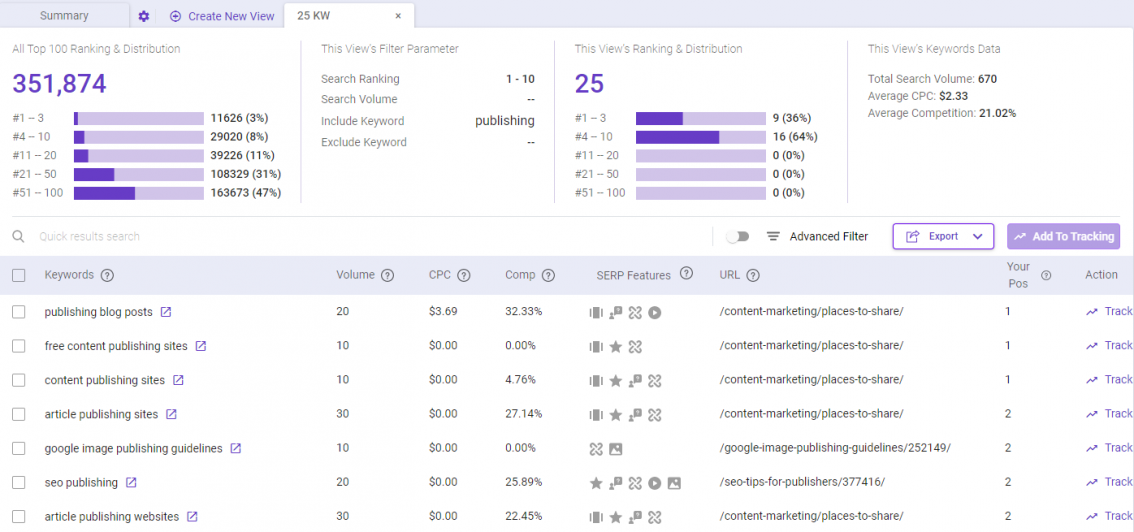
Posts that are at the 2-10th ranking can surely be optimized because a successful update may bring the post further to the top
2. See if the post is relevant after updating
It all depends on the type of content that it is. For instance, if your content is about “Best Music in 2020”, then it can be optimized to “Best Music in 2021”.
It is all about the relevancy of the post even after updating. If your post is more of a seasonal content or history, then it is not worth the update if it’s underperforming.
3. The post is gaining traction in search results
If your post is getting less organic traffic but there is increased traction in the search results for the target keyword, then it is possible that if your content is re-optimized, it will help boost your ranking on the search page.
It could be due to a dubious headline, or some repetitive content. Fix your content, it will surely do better than the first time.
4. Your content’s rank is dropping
If your article used to have a good position in the SERP but it’s starting to drop, all you need to do to regain that position again is to reoptimize content of that post.
You can track the performance of your content using BiQ’s Rank Tracking tool.
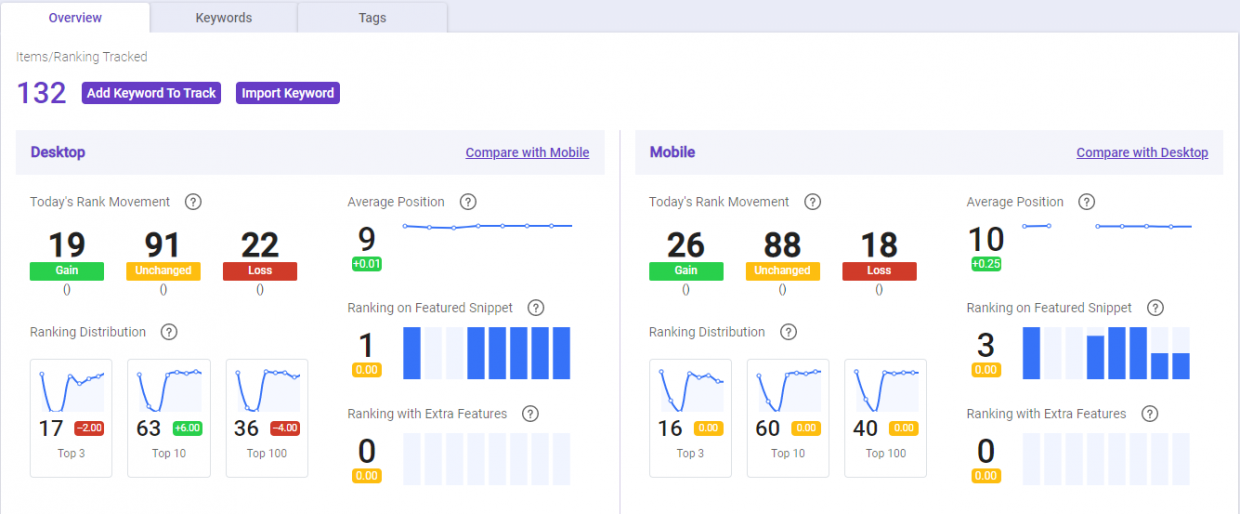
Using BiQ’s Rank Tracking, you can easily link your ranking positions to your SEO efforts and processes. Find out what are the actions that lead to your keyword rankings growth.
Whether you have just built some backlinks to your website or included target keywords in your post’s title and meta description, BiQ’s Rank Tracking can help understand which are the actions that have led to your SEO success.
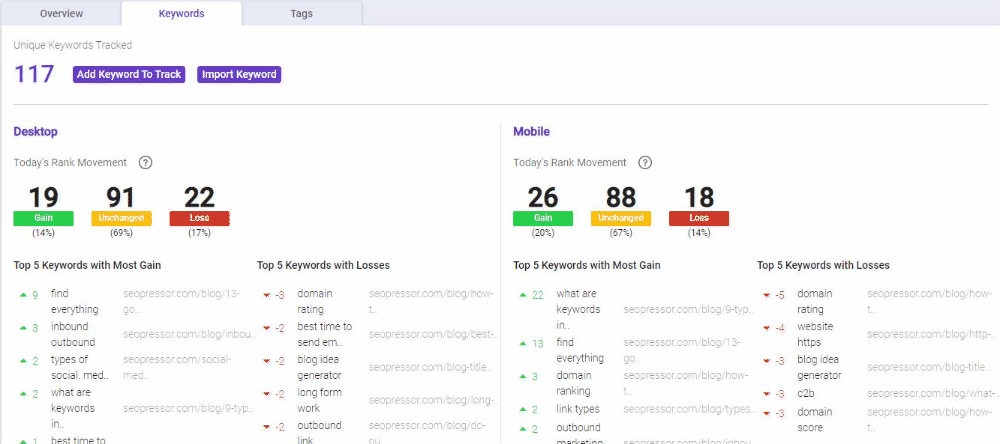
You can also check on the ranking pages and keywords progress at the “Keywords” tab.
Doing so would give you a bird’s eye view of your ranking data easily, especially when you are looking for daily or weekly changes.
This is important to understand what works for your website SEO, as well as actionable data on what to avoid so you can quickly recover your lost rankings.
5. Posts with high bounce rates
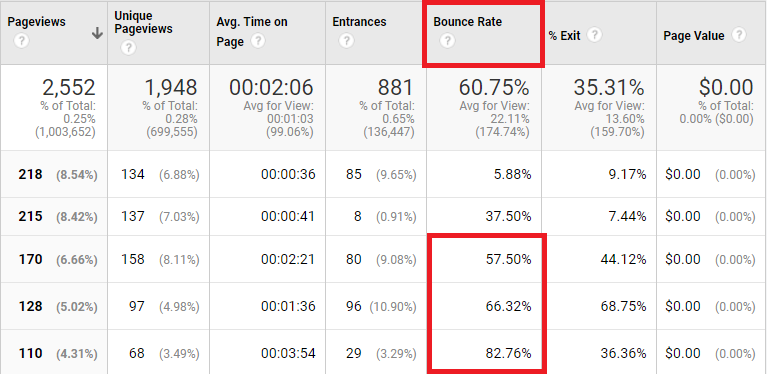
A site’s bounce rate is important because it lets you in on the user experience and the engagement with the webpage’s content.
A high bounce rate might indicate some technical SEO issues, such as your page load time is too slow. There are many problems leading to this, and there are several things you can do to reoptimize your content in order to lower the bounce rate.
Reoptimize old content to get an optimal bounce rate of 26% to 40% range.
Conclusion
If done right, content optimization will bring you many benefits. Instead of writing from scratch, reoptimize the old content or blog posts and give them the boost that is needed.
Using these 5 strategic approaches to content optimization will definitely help you to increase organic traffic, improve your rankings and also boost conversions.
Be a little creative to get the most out of what you already created!




